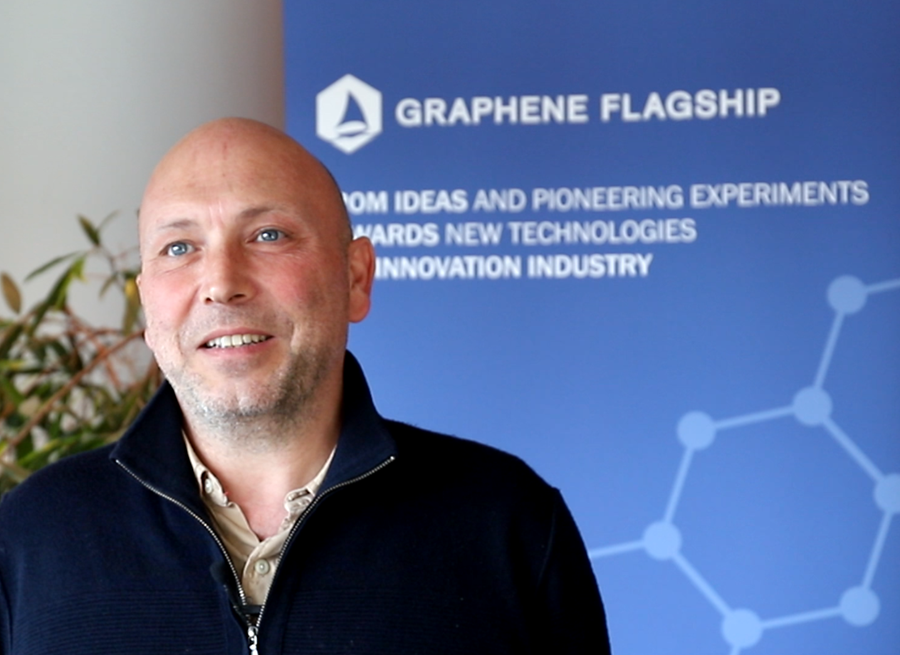Carlo Iorio talks about his appointment as the Graphene Flagship’s Space Champion, and explains how graphene could take humanity to infinity and beyond
The Graphene Flagship has appointed Carlo Iorio as their Space Champion, to act as a spokesperson and interface for the Graphene Flagship’s efforts towards the integration of graphene and layered materials into space science and technology.
Carlo Iorio is a Senior Researcher at the Microgravity Research Centre at the Graphene Flagship partner Université Libre de Bruxelles in Belgium. His research interests focus on mankind's exploration of the final frontier – in particular by developing new materials to enable stronger and more reliable vessels for space travel. The Graphene Flagship has appointed him as their Space Champion, to act as a spokesperson and interface for the Graphene Flagship's efforts towards the integration of graphene and layered materials into space science and technology.
Carlo works in the Graphene Flagship's Composites Work Package, and co-organizes the joint ESA–Graphene Flagship symposium at Graphene Week, which will celebrate its third birthday in Strasbourg in September 2020.
I interviewed Carlo about his research, his appointment as the Graphene Flagship Space Champion, and his views on humanity's foray into the dark beyond.
Can you tell me a bit about your role as the Graphene Flagship Space Champion?
Since I have a lot of experience working on graphene and layered materials for applications in space exploration, the Graphene Flagship's Management Panel asked me to represent the Graphene Flagship for space-related research involving graphene and related materials. It will be my duty to drive innovation in this field, and to coordinate new and existing projects that help bring technology enabled by graphene and layered materials to the forefront of space exploration.
How did you get to where you are today?
I have a master's degree in Aerospace Engineering, and I did my PhD at the University of Brussels, where I conducted research on heat and mass transfer in space applications. After this, I was put in charge of a research unit working on hydrogels with biomedical applications in space, which really broadened my horizons. This is what led me to start working with graphene. I am particularly interested in making graphene-enhanced hydrogels to create better and more mechanically resistant materials for spacecraft.
What are you working on right now?
I am collaborating with Graphene Flagship partner company Leonardo, and graphene Flagship partners CNR and University of Cambridge, on a new cooling system using graphene-enhanced loop heat pipes. These are a low-energy, low-maintenance solution to thermal management onboard spacecraft. The results obtained so far are really encouraging. We will do more tests under microgravity conditions by taking advantage of the ESA's parabolic flight campaign – and when the full system is at a more advanced stage, we could go for longer-lasting platforms.
Other than that, I am currently using graphene to strengthen the mechanical properties of hydrogel-based building materials, so we can build lighter and stronger spacecraft. I am also looking into the interactions of graphene with human cells. This is a hot topic, especially in the Graphene Flagship, thanks to the potential of graphene for biomedical applications.
In November 2020, the Graphene Flagship will be running another Parabolic Flight Campaign. On this occasion, we will investigate the various interactions of graphene-based hydrogels in zero-gravity. We will seed them with different kinds of cells, like fibroblasts, in order to evaluate the motility inside hydrogels. At the same time, we will test the resistance of hydrogels against the high levels of acceleration they will be subjected to on space missions.
Where do you see humanity, in terms of space exploration, over the next few decades?
This depends on the scale of the exploration that we want to achieve. I think that in 10 to 15 years, we can establish a small colony on the Moon. I am less confident on the timing for Mars, but I think a colony on Mars might be achievable in 30 to 50 years – although there are a lot of challenges that humans need to address beforehand.
We are at the beginning of a new revolution in space exploration, and the word 'revolution' is certainly not a small term for what is happening now. It has been just over 20 years since the launch of the International Space Station (ISS), and for most of that time, there were very few new developments. But over the past five or six years, there has been a really thrilling atmosphere among space scientists. We have the European Space Agency, NASA, the Chinese Space Agency and the Russian Space Agency, all considering space as the new frontier again. Our target is to create a base on the moon, and then use this as a platform to go to Mars further down the line.
What are the main challenges these space agencies, and the Graphene Flagship, are facing?
Firstly, we need devices and systems to be extremely reliable. On Earth, when something goes wrong, you can fix the problem because you have access to instruments and labs. But in space, failure can be catastrophic because the luxuries of external support and servicing are not available.
If we want to have people living and working on the moon, we will need water, and we will need the technology to extract, refine and purify it. But to extract water in an environment where the temperature can go from hundreds of degrees above zero to hundreds of degrees below zero, we need an intricate thermal management system. The Graphene Flagship is developing new technology that can address this: a system of loop pipes that could be used for thermal management in satellites, planes, and of course, space exploration.
We will also need some new orbiters to transmit data to Earth. For this, we need devices that can increase the rate of data transmission across long distances. Mars is even further away than the ISS and the Moon, so technology to communicate across the solar system could be a potential breakthrough in space exploration.
But the main thing we will need to overcome, before we can get to Mars and beyond, is our lack of technology for radiation shielding. When we go to Mars, it will be a trip that could last from a few months to over a year. The astronauts will be subjected to very dangerous cosmic radiation, and right now, there is no shield that could protect them from this. There are a few solutions being talked about. We could use graphene to develop better-protected spacecraft, which is what I'm working on at the moment, or we could reduce the risk by simply getting there faster – potentially by using graphene to make better engines.
How can graphene help us to build better spacecraft?
Current spacecraft are protected by materials like polyethylene, or materials that are water-rich. They are very good, but as with everything that gets taken to space, we have to pay the price of transporting extra weight. This is expensive, especially for materials containing water. We are now testing porous materials that can be graphene-based, or alternatively, embedded with water-based materials like hydrogels. Some groups, such as in the Microgravity Research Centre at Graphene Flagship partner Université Libre de Bruxelles, are even working on lightweight composites comprising graphene-enhanced polyethylene particles.
These materials are being put through meticulous tests, like at the GSI particle accelerator in Darmstadt, where they expose the materials to cosmic radiation and observe their performance. We are hoping to have positive results, showing that graphene can be effective when mixed with other, lightweight materials, to create new lightweight structures that can resist radiation.
However, we should not consider graphene as the solution to all problems. There are challenges that require the development of new materials with specific and adaptable properties. Over the history of mankind, we have had many revolutions, and science keeps advancing. 300 years ago, people were not talking about gravity much, but now we can even calculate the deflection of light through a black hole. In the same way, graphene has great potential to enable very reliable composites that can be functionalised. We are at a relatively early stage right now, but graphene is one of the best candidates to help us solve these challenges.
Are there any other things we need to consider?
Space exploration is a moral issue as well. We have to consider what we are capable of, and what our goals are.
In the space community, there are long-lasting discussions about whether or not we should terraform Mars. We could introduce some bacteria to slowly lower the CO2 content of the atmosphere and gradually make Mars closer to the living conditions on Earth. But, do we have the right to do this?
From a human perspective, we could immediately say yes – there are many bacteria that can resist extreme environments, and they could even be genetically modified. The problem is whether we want to take responsibility for this. Maybe terraforming would be okay, but at what cost? Would we also export our pollution, conflicts and wars to other planets?
One day, we might need to abandon Earth. How will humans deal with this? Will we have big vessels colonising planets, travelling around the universe? This is one of the most difficult questions that mankind as a whole will need to answer. It is interesting to think about it. Of course, right now, this is outside of the realms of our current technology. But this is something that will need to be answered by us as human beings, rather than as scientists.

Carlo Iorio, Graphene Flagship Space Champion




